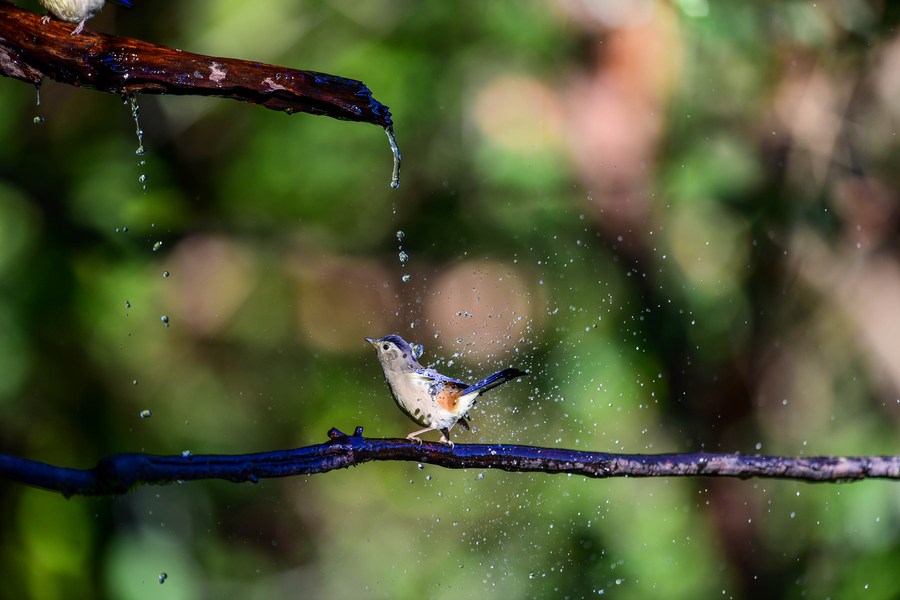Better sanctuaries draw more feathery visitors in winter

A bird bathes at the "bird pond" built by Hou Tiguo in Baihualing, a village sitting at the eastern foot of the Gaoligong Mountains, Baoshan City, southwest China's Yunnan Province, on Dec. 4, 2020. (Xinhua/Hu Chao)
KUNMING, Oct. 14 (Xinhua) -- Despite the drizzle, Zhao Xuebing stood on the bank of Dianchi Lake observing the sky through binoculars.
Zhao, the secretary-general of the bird society of Kunming, capital of southwest China's Yunnan Province, was waiting for the arrival of black-headed gulls, a type of migratory bird species that fly in from Russia's Siberian region. Dianchi Lake is a major habitat of the species in Yunnan.
"They haven't shown up," he said, adding that the birds usually arrive in mid- or late October, but the exact time varies every year.
Known as the "City of Spring," Kunming is warm in winter and lakes like Dianchi are rich in fish and shrimp -- ideal food for birds. Under the guidance of professional staff, local residents like feeding birds as their complementary diet, attracting migratory birds to spend winters here.
Even during the COVID-19 epidemic last year, when some of their habitats across the city were temporarily closed, authorities organized staff to feed the birds.
The number of black-headed gulls flying to Kunming hit a record high of 41,600 last year, according to Zhao. "The black-headed gulls have become a symbol for Kunming," he said.
As China continues to emphasize sustainable development and strengthen efforts in biodiversity conservation, more and more migratory birds are seen here during the winter months.
After a journey of over 5,000 km across mountains and rivers, the Siberian white cranes land at Poyang Lake in east China's Jiangxi Province, their winter home.
Siberian white cranes, also known as snow cranes, are listed as critically endangered by the International Union for Conservation of Nature, as their population has dwindled to about 4,000, with only a single migrating route left -- the east route to Poyang Lake, China's largest freshwater lake.
Local governments and institutions have used new technologies including 5G, unmanned aerial vehicles and real-time monitoring for bird protection.
Thanks to sustained efforts to preserve the habitat, Poyang Lake saw an increasing number of feathery visitors, attracting more than 680,000 wintering birds in 2020, about 11,000 more than the previous year. Now, it has become common to find flocks of Siberian white cranes in the lake area.
"I finally see snow cranes dancing. That was a dream during my childhood," said Mira Ushkanova, from the Russia-China Friendship Association, who visited the lake last winter.
Ushkanova is from Russia's Sakha (Yakutia) Republic, a major habitat of Siberian white cranes where they reproduce. She said in her hometown, people believe the cranes are auspicious.
She said she was delighted to see the birds from her hometown are taken good care of at the other end of their migratory route, believing that efforts in protecting the birds will also bring happiness to Chinese people.
At the wetland along the Yellow River in Pinglu County, north China's Shanxi Province, swans from Siberia show up every winter.
The wetland spanning more than 6,000 hectares is one of the three major habitats in China for the species to spend winter.
To protect them, Pinglu County has shut down polluting plants nearby, and invested heavily to improve the ecology. A protection team of more than 100 people has been formed, with a remote video monitoring system installed, according to the county government. Over the past 10 years, the government pays some 400,000 yuan (about 62,000 U.S. dollars) every year to compensate farmers who have sacrificed their farmland to the wetland.
Local governments along birds' migratory routes also issue circulars every March, when the birds return to Siberia, and assign monitoring staff to prevent the birds from being hurt.
"The constantly improving eco-environment is the best way to safeguard their migratory journey," said Zhang Jin, an official with the forestry bureau of Pinglu County.
China and Russia have deepened cooperation in protecting the migratory birds and signed a series of agreements, including a memorandum of understanding of Siberian crane research and conservation.
Zhao Xuebing expected that the ongoing 15th meeting of the Conference of the Parties to the Convention on Biological Diversity held in Kunming will further promote the cooperation between China and Russia to protect the migratory birds and other wildlife species.
"There are no national boundaries for migratory birds. Joint efforts are needed for their protection," said Zhao.
Photos
Related Stories
Copyright © 2021 People's Daily Online. All Rights Reserved.










